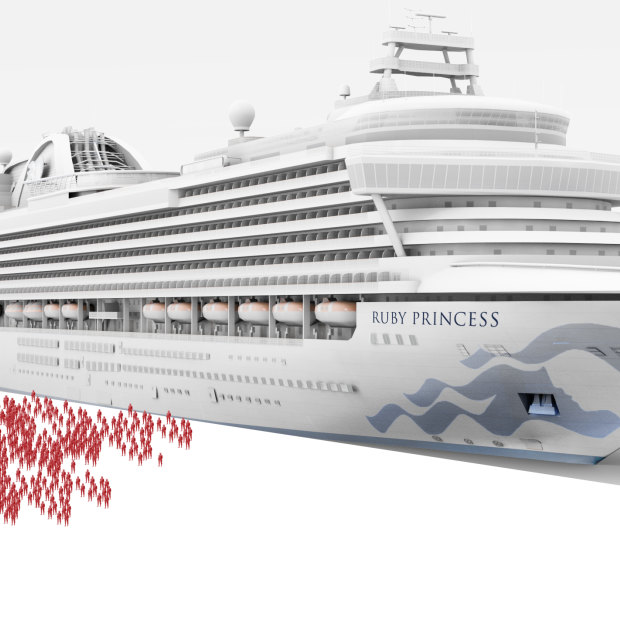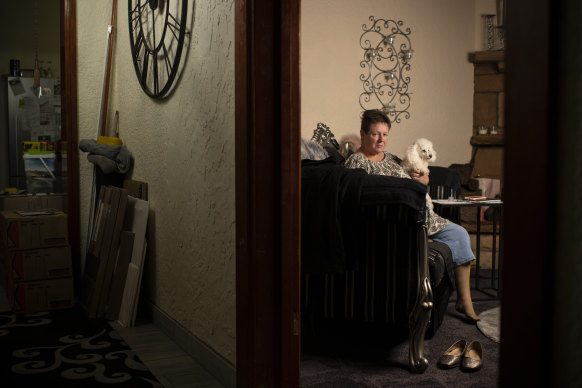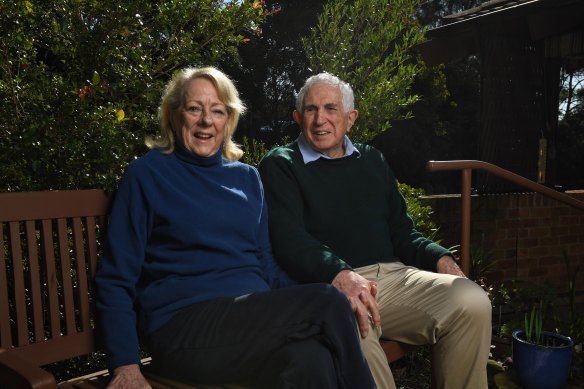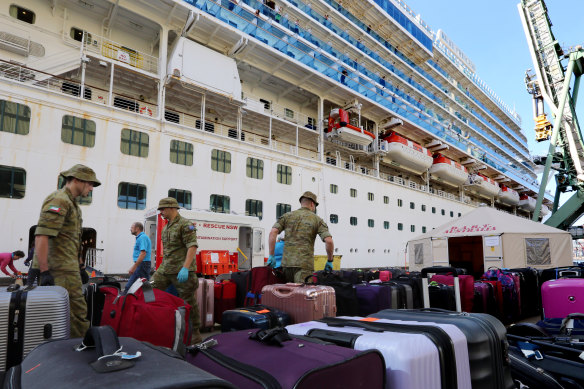This was published 4 years ago
Return to troubled waters: inquiry to report on Ruby Princess fallout
Editor’s note: This article was first published August 13, 2020. It was the ill-fated cruise ship that spawned more than 900 COVID-19 cases and on Friday an inquiry will hand down its findings into the handling of the debacle.

Ruby Princess artist's impression. Credit: Mark Stehle
It was a strange job. Shuttle driver Julie Lamrock was booked to pick up a passenger from Campbelltown and drive her to Circular Quay to join the Ruby Princess on March 8, but there was delay after delay, and she could tell her client was getting the wobbles. "The health department’s down there and they're not allowing anyone on the ship until it gets clear," Ms Lamrock's passenger said. "Should I go?"
Of course she should, Ms Lamrock replied. "The government wouldn't let you on the ship unless it was fine."
Ms Lamrock is pained now to recall her reassurances. It is notorious that the Ruby Princess would spawn Australia's biggest coronavirus cluster — a record that it held until July when it was eclipsed by Melbourne's hotel quarantine debacle. On March 20, NSW Health Minister Brad Hazzard revealed that 24 hours after the ship's 2647 passengers were allowed to disembark and travel home, three COVID-19 tests performed on board had returned positive. Potentially thousands of cases had been allowed to scatter like marbles to all corners of the country and around the world.
Recriminations swung between state and federal agencies. The issue dominated the news cycle for weeks. It seemed the seminal event that would saturate Australia with coronavirus and which epidemiologists had been half-expecting had arrived. The country held its breath.

Shuttle driver Julie Lamrock contracted coronavirus after she picked up a Ruby Princess cruise ship passenger who later tested positive. Credit: Wolter Peeters
It never eventuated. In the weeks that followed, 712 passengers and 202 crew tested positive and 22 people died. But only 19 people in NSW and 15 people interstate were infected by those passengers. And aside from Tasmania, where a hospital cluster swelled to 114 people for separate reasons, only three people caught it from secondary patients. (The international figures are unknown.) Within two months, the outbreak was contained.
An inquiry due to report on Friday spent 21 days examining how the cruise ship was allowed to disgorge its passengers when there were suspect cases on board, before the results of COVID-19 swabs were known. But the vast majority of people who can blame the Ruby Princess for their troubles would have contracted coronavirus anyway.
Commissioner Bret Walker, SC, pondered on this with the senior counsel assisting, Richard Beasley, SC, on the penultimate day of the inquiry. "One thing I want to be able to address finally is, does any of this matter?" the commissioner said.
Commissioner: "Does any of this matter in the sense that everyone was going to home isolation, with or without testing ... no harm done, no community spread? It is a very interesting point. It might only be a footnote, ultimately, because you don't test, I think, the narrative of public health precautions by whether or not you dodged a bullet."
Mr Beasley: "Yes."
Commissioner: "I don't think."
Mr Beasley: "No you don't."
Commissioner: "In any event, we didn't dodge a bullet."
Mr Beasley: "We did not."
Pandemic protocols
Back on March 8, Ms Lamrock's passenger was not the only one feeling nervous about the cruise going ahead. The Ruby Princess's previous voyage to New Zealand had been classified "medium risk" of carrying coronavirus patients when it returned to Sydney, under a new set of protocols that were developed in response to the pandemic. This meant it required NSW Health staff to inspect the ship before passengers were allowed to disembark.
Senior epidemiologist Kelly-Anne Ressler chatted to the ship's doctor Ilse von Watzdorf about the inherent risk of cruising during a pandemic. "They just have to stop all cruise ships," Dr von Watzdorf said.
Almost immediately after the Ruby Princess set sail that evening, people started presenting with respiratory symptoms. The first passenger to later test positive for COVID-19 went to the ship's hospital the day after it left Sydney. When the ship reached Fiordland, its first destination in New Zealand, on March 11, six people had visited the ship's doctor. Five people were swabbed for coronavirus in Wellington on March 14, but all returned negative results.
When it docked at Napier on March 15, 34 people were on the illness log. Dr von Watzdorf emailed Ms Ressler. "We seem to be in the early phases of an influenza A outbreak on board," she said.
Mosman resident Fred Jackson, 79, had decided not to actively socialise with other passengers, but said it was almost impossible to physically distance. The tender that brought passengers to shore was packed with 100 people "breathing all over each other", he said.
The driver of the wine tour bus in Napier would not allow passengers in the front row due to COVID-19 concerns. "But there was nothing for the rest of us, we were all packed in," said Mr Jackson, who would spend nearly a month in hospital on his return to Sydney after contracting the disease.
"Now I look back on it, our waiter was coughing quite a bit over where the food was. He had the type of cough we developed when we got back. It was a dry cough."

Fred Jackson and Julia Annette were both hospitalised after contracting COVID-19 on the Ruby Princess.Credit: Nick Moir
Although passengers who presented with respiratory symptoms were supposed to be swabbed for COVID-19 under the guidelines, a global shortage meant there were only 25 swabs on board. The company had ordered more swabs and the ship planned to collect them in Auckland, but that same day Prime Minister Scott Morrison announced a ban on cruise ships and the Ruby Princess cut short its voyage by two days, skipping Auckland. Just 13 patients were swabbed during the voyage.
By March 17, 50 passengers had reported respiratory symptoms and a message went out over the PA system encouraging people to see the ship's doctor, resulting in a deluge of people to the sick bay. A carnival manager emailed his colleague: "Also ruby numbers gone Beserk [sic] in last 48 hours. I took my eyes off the game yesterday."
As the ship powered back to Sydney, the coronavirus protocols developed in February swung into force. In pre-COVID times, NSW Health leaned on information provided by the Department of Agriculture to waive through passengers. But the new procedure required its own staff to make an assessment of coronavirus risk based on the number of respiratory patients on board and which countries those passengers had visited prior to boarding.
A ship could be classified as "low risk" if fewer than 1 per cent of passengers had respiratory symptoms. Low-risk ships did not require NSW Health teams to board the ship and make an assessment on whether passengers should be stopped from disembarking.
This was partly a matter of resourcing. During the development of the protocols, Professor Mark Ferson, the director of the public health unit responsible for the cruise ship program, argued against requiring his staff to meet every ship. He emailed in response to one draft version: "The down side of having a team meet each boat (apart from the cost and wear on staff) is that if a passenger is diagnosed incidentally after disembarking, we will be asked why we missed a case and it will look worse for everyone."
As he was to later explain, the burden on his team was in fact the bigger concern, as it would have increased their workload "multifold" at a time when they were already working long hours. It played into his thinking both in terms of how risk should be assessed and in whether teams should meet the boats. "I would have to say that ... the need to find resources was an important consideration in how we would manage the ships in terms of risk rating," he told the inquiry.
At 8.55am on March 18, a day before the ship was due to dock, it reported on the risk assessment form that 110 people on board were ill and 17 had a fever. And only 0.94 per cent of the ship's population was reporting flu-like symptoms — just below the 1 per cent figure that would have categorised it as medium risk. Crucially, the form specified that none of the passengers had been to China, Iran, Italy or South Korea, which would have rung alarm bells among the health officials reading the report. However, 22 per cent of passengers on the Ruby Princess had links to the United States, which was by then a known hotspot. But health bureaucrats had not updated the form to ask whether passengers had visited any other countries, so that information was not before the officials.
Over the next 24 hours, case numbers continued to grow. By the time the cruise returned to Circular Quay in the early hours of March 19, 124 passengers and crew members were listed on the medical log, and the proportion of passengers with flu-like symptoms had tipped above 1 per cent and into "medium-risk" territory. But the form had already been sent.
High-fiving farewell
When the Ruby Princess docked in Sydney at 3am, ambulances were waiting. Two patients had febrile respiratory tract issues and neither had tested positive for influenza. Carnival Australia port agent Dobrila Tokovic took their swabs for COVID-19, along with three other swabs, and delivered them to a driver to take to a laboratory for urgent testing. She was told the results would be ready by 4pm. Four hours later, passengers began piling out of the ship.
The crew lined up to farewell them with high-fives. They caught 10 connecting flights and dispersed to more than 500 different postcodes around Australia, as well as countries including the US, the UK, South Africa and Argentina.
Julie Lamrock collected her passenger and spent about an hour with her in the car back to Campbelltown. On the way, the passenger wanted to get out and shop at Aldi but Ms Lamrock said she could not wait when they saw a queue of customers snaking out the door. "Imagine all those people in Aldi she could have infected," Ms Lamrock said. Driver and passenger would later both test positive to COVID-19.
At 4pm, Ms Tokovic called the laboratory to find out the results of the swabs, only to learn they had not been tested. The technician did not realise they were a priority.
Mr Beasley argued in his closing address to the inquiry that the swabs should have been expedited at 3am when the ship berthed, far from the delay that eventuated. It was a failing both compounded and caused by the release of passengers, for events could have transpired differently if everybody was still waiting on board. The commissioner mused: "It seems highly likely, doesn't it, that those swabs would have been shepherded through laboratory testing rather than being put on a shelf to wait their turn."
The next morning, Ruby Princess passenger Kim Walters was waiting at Sydney airport to catch a flight back to Tasmania when she received a call from NSW Health. The swab that had been taken from her on board the ship had returned a positive result and an ambulance was coming to get her. She would be put in an induced coma for 25 days.
'I went through hell'
Passengers continued to fall victim to the virus until mid-April and the crew members continued to test positive up until April 20. The last person to die within the Ruby Princess outbreak was on May 13, about two months after the voyage – a vastly different scenario to Victoria where more than 14,200 cases of community transmission and nearly 250 deaths have been recorded since a staff member at a quarantine hotel, the Rydges on Swanston in Melbourne, tested positive for COVID-19 on May 27.
Ms Lamrock is among the few people infected in the Ruby outbreak with a genuine gripe that she would have been saved if passengers were not allowed off the boat. She started feeling unwell within a week of picking up her passenger. She is still battling debilitating post-viral symptoms and has not worked since.
"I went through hell, absolute hell," she said. "It's with me for the rest of my life now. I'm worried about complications when I get into my 80s. All because the Ruby Princess let their passengers off."
Mary-Louise McLaws, a professor of epidemiology at UNSW, said the Ruby Princess might have played out better than the Melbourne outbreak because the cruise passengers were older, so they probably had less social connectivity and did not live in crowded households or work across several casual job sites.
"We are very, very, very fortunate that they either remained at home or they were going home on public transport while ... their viral load was low and they weren’t shedding it," Professor McLaws said.
"Anybody in their 60s or 70s … would probably want to unpack and stay at home for a couple of days. We were lucky that they didn’t cause infection in public when they were restocking their fridges."
The 2700-odd people who poured off the ship on March 19 mostly went home and isolated as they were advised to do. Many of them started to feel unwell. Some of them died. But they did not set off large chains of transmission. It will be of little comfort to them to know that the darkest fears of health officials did not play out.
Their fate was sealed on a damp day in March, when against the better judgment of the ship's senior doctor, the Ruby Princess peeled away from Circular Quay.

Repatriation time for the Ruby Princess's international crew members.Credit: NSW Police